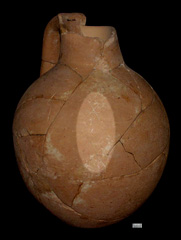| Visiting | Features | The Collections |
Services | Online Resources |
More Resources |
SiteMap |
 |
Ashmolean Museum of Art and Archaeology |
|
|
| AMULETs | |||
| Ancient
Cyprus in the Ashmolean Museum |
| Cypriot Copper: Mysteries of the Bronze Age | |||
|
Textual Evidence
|
|||
The only script from the Bronze Age found on Cyprus is called "Cypro-Minoan", which consists of characters that were incised on objects or written into baked clay tablets. The script is not yet fully understood. It is likely that these symbols had an administrative use. The earliest example so far was found at Enkomi, and dated to c. 1500 BC (Karageorghis 1982, 63). Some characters of Cypro-Minoan are engraved on this jug and the two sherds. |
|||
 |
 |
 |
|
| Pot Sherd, Hala Sultan Tekke-Viraja, from excavations by H. Catling (AN1953.391) | Pot Sherd, Enkomi, from excavations by H. Catling (AN1960.671) | Jug, Myrtou-Pigadhes, from excavations by the Ashmolean and Sydney University (AN1963.162) |
| Other terms in various languages thought to refer to Cyprus or ancient metals include: | |||||||||||||||||||||||||||||||||||||
|
| Letters found at Tell El-Amarna in Egypt record communications between the Egyptian pharaoh Akhenaten (1350-1334BC) and foreign leaders in the period equivalent to the middle of the Late Bronze Age. One set of letters records a series of tributary gifts sent from the King of Alashiya, which some scholars identify as the name of Cyprus in the Bronze Age. | |
| Text of Letter 40. From the Minister of Alasia to the Minister of Egypt. | ||
|
ahi a-na [p]a-n[i Su-m]i-it-ti |
My brother, t[o Sum]itti I have sent |
|
For a variety of reasons, not all academics agree that Alashiya should be translated as Cyprus. |
||
| Previous
Page (The Copper Trade) |
Introduction
to the Mysteries of the Bronze Age |
Next
Page (Weapons) |
|
| Ancient Cyprus in the Ashmolean |
© Copyright University of Oxford, Ashmolean Museum, 2004 The Ashmolean Museum retains the copyright of all materials used here and in its Museum Web pages. Last updated: 21-oct-2004 |
|
HomePage | Visiting
| Features
| The Collections Services | Online Resources | More Resources | SiteMap | Top of Page |